How To Clean Artificial Grass Guide (Artificial Turf Maintenance)
By Jennifer Williams
January 10, 2024 • Fact checked by Dumb Little Man
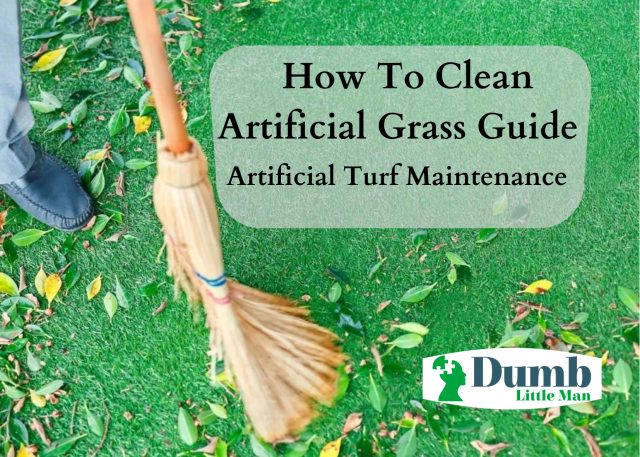
One of the most enticing aspects of installing artificial turf is how little upkeep it takes compared to the level of grass care required by most gardens. Thanks to the synthetic material, you won’t have to worry about mowing the grass or traveling to the garden center to purchase additional fertilizer, thus saving you time and money while guaranteeing the area is safe for both children and pets.
With that being stated, if you want to keep your lawn looking great all year, you’ll need to undergo turf maintenance every now and again, which is why we have created a simple guide on the best methods for cleaning artificial grass and keeping your lawn in good shape. Let’s get into it.
How to Maintain Artificial Grass?
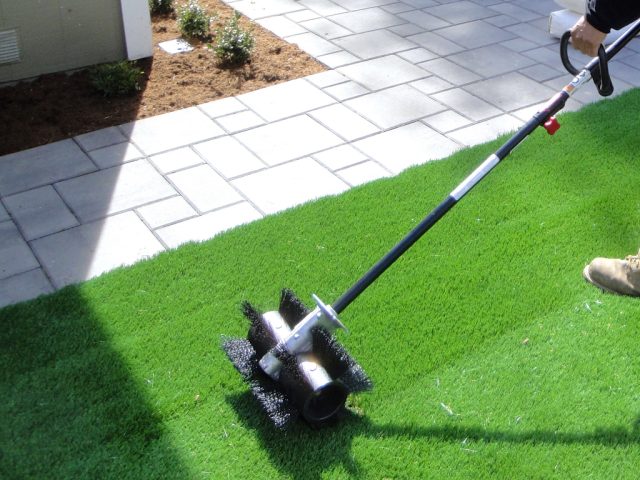
The frequency with which you must conduct artificial turf maintenance will be determined by your specific circumstances, such as the size of your turf and the elements it is exposed to. For example, if you have pets that use the lawn, children, or many trees and bushes in the surrounding area, you will likely need to care for your synthetic lawn more frequently. On top of this, If you live in a very dusty region such as Texas, Colorado, or New Mexico, then you may want to carry out artificial grass care more often. During rainy months, on the other hand, you can let the rain wash your grass which means that you will not need to clean it as regularly.
What Tools Are Required for Turf Maintenance?
Fortunately, you don’t need too many tools to carry out artificial turf maintenance since there isn’t much requirement for gardening equipment. With that said, the following tools could come in handy when conducting lawn turf care:
- Hose
- Stiff Brush
- Rake (Plastic Is Preferred)
- Leaf Blower
- Hedge Trimmer Weed Killer
- Lawn Detergent
- Professional Cleaner For Pet Waste
How to Remove Pet Waste from Artificial Grass?

If you have pets, you will know just how frustrating it can be when your furry friends come along and spoil your perfectly maintained turf. While synthetic grass maintenance is relatively straightforward, sometimes pet waste can get a little tricky. With that said, here are some simple steps to follow:
① Remove the waste
The first step to cleaning turf with pet waste is to pick it up as soon as you notice it. Use a pooper scooper, or whatever your preferred means for collecting your pet’s waste is
② Spray/hose the area
The next thing you need to follow is to spray or hose down the area. Since the waste will not naturally drain away or decompose into the soil, you need to spray the area down to remove any residues and keep it free from dirt.
③ Continually clean the area
As you know, pets normally have a favorite spot to do their business. Whether it’s in the corner of the garden away from prying eyes or right in the middle of your lawn, our furry friends are certainly creatures of habit. With this in mind, you need to pay extra attention to these areas when cleaning, as they will, of course, be some of the dirtiest areas of your garden. If you have children, it’s especially important to keep on top of this as pet waste is a perfect breeding ground for bacteria and germs. In general, you should spray down these areas at least once or twice a week.
④ Use a specialist product if required
Let’s be honest, pet poop and urine don’t smell the best. If you leave it there long enough, it will begin to create a foul odor that might even get your neighbors complaining. To prevent this, opt for specialist artificial grass products that are designed to deal with pet waste.
How to Remove Bacteria from Synthetic Grass?
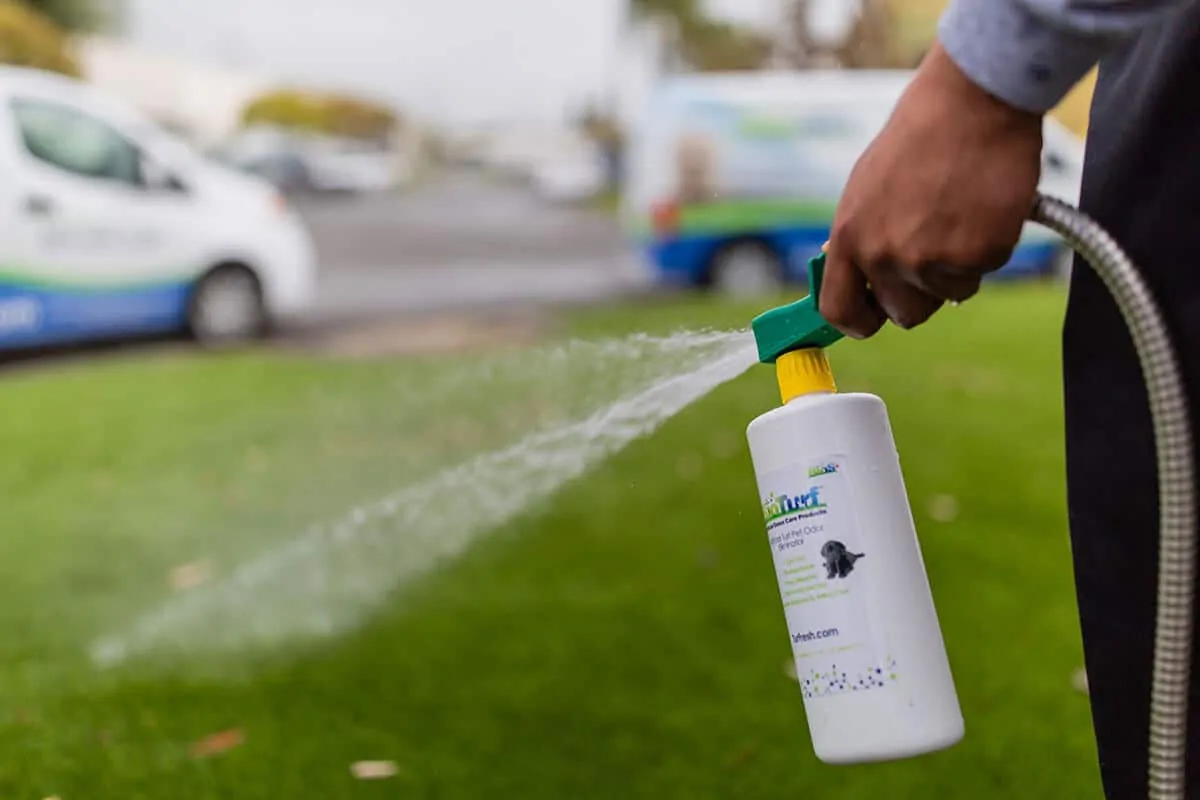
For the most part, bacterial growth is seldom an issue with artificial grass that is cleaned and maintained regularly. With that said, there may be times where you feel like bacteria is taking hold of your precious lawn, in which cases, you will need to take swift action. So if you’re wondering how to clean turf grass that has a bacteria issue, here’s what you need to do.
The first step is to start cleaning artificial grass with vinegar. To get rid of bacteria spores, combine vinegar and water in a half-and-half solution. You can use this combination in a spray bottle if the area is quite small, such as the location where your pet often urinates. If you want to treat your entire lawn, you may use a garden hose attachment, such as those used to spray fertilizer, to treat bigger areas while also removing germs from the lawn. If any of the bacteria strains are very stubborn, you may need to use a rough brush and a little elbow grease.
How to Avoid Stains and Burns?
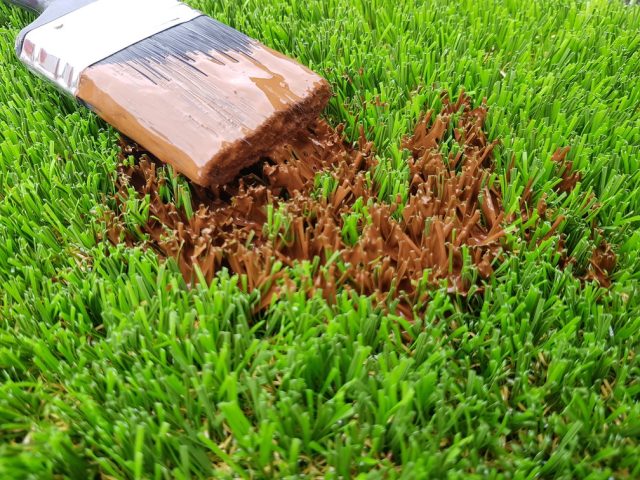
As they say, prevention is always better than the cure – and that is certainly the case when it comes to stains and burns on your lawn. Unfortunately, cleaning artificial turf that has been burned or stained is rather tricky since, unlike grass, it will not grow back and repair itself. With this in mind, it is highly advised to keep things such as barbeques, cigarettes, and anything that is highly acidic away from your lawn. This includes things like car batteries, lubricants, and motor oil – so if you need to work on your car, it’s better to do it somewhere else.
How to Remove Snow and Ice from Synthetic Grass?
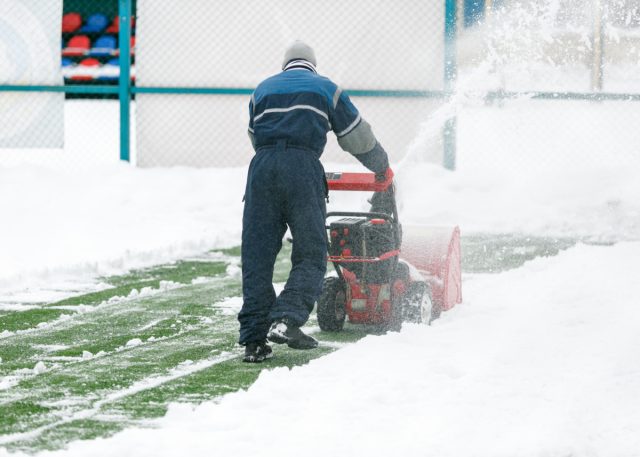
When it comes to artificial grass maintenance in the winter, there really isn’t too much you need to worry about. The good news is that cold temperatures can’t really cause much damage to your lawn, and snow and ice will naturally melt away once the weather heats up again.
Of course, if the snow gets too high, then you will need to get your shovel out to conduct some artificial turf maintenance, but that’s only if you need to access the area. With that said, it is possible to damage your lawn when carrying out artificial grass maintenance of this kind since you may get your shovel a little too deep and scratch away at the material underneath. To prevent this, try to save at least a few inches of snow while digging and then get rid of the excess snow with a broom or brush.
How to Prevent Burnt Turf from Window Magnification?
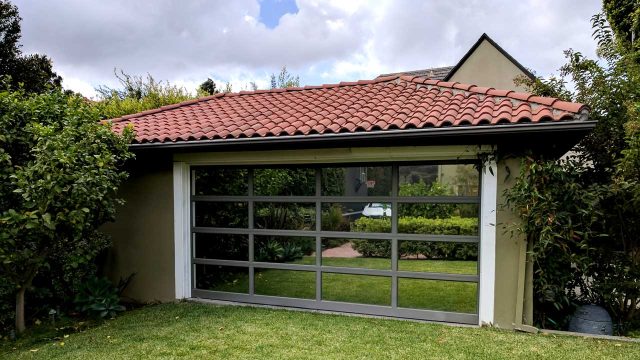
Remember that game you used to play as a kid when you would burn objects with a magnifying glass? If the sun reflects off your windows at the right angle, the same thing may happen to your lawn. You should be concerned about this only if you live in a hot climate; however, it’s worth double-checking even if you live in a cooler climate – especially during the summer months.
Once again, the best thing to do here is to prevent the damage before it occurs, as once your lawn is burned, you will probably need to get the damaged area replaced. So, how do you do this? Well, all you need to do is to somehow find a way to block the window glare that is causing the issue. This could mean installing shutters, awnings, or screens to minimize the magnifying effect. On the other hand, you could protect the lawn that is exposed to this glare by placing furniture over the top of it or covering it, for example.
How to Clean Mild Stains, Stubborn Stains?
Finally, if you want to keep your lawn in tip-top condition, you need to know how to clean artificial grass once it gets stained. After all, life happens, and you can’t always protect your lawn from spillages and general wear and tear.
With that in mind, if you spot a mild stain on your lawn, the best thing to do is treat the area as quickly as possible. The longer it has to settle, the more difficult it will be to remove. Therefore, you should clean the stained areas as soon as possible, and if it doesn’t come out with water, then add detergent and scrub the area until it is removed.
In addition to this, you will also need to know how to clean artificial turf that has suffered more stubborn stains, such as motor oil, grease, suntan lotion, and anything else that can’t be removed with ease. With these types of stains, you will probably need to buy some specialist detergent that is designed for this purpose. If this doesn’t work, try adding vinegar or mineral spirits, and see if the stain will lift.
If all else fails, it’s time to call in the experts. With that in mind, don’t hesitate to contact us, and we will do our best to get your turf looking back to its best once again.
Jennifer Williams
Jennifer Williams is a PR & Communications specialist working with Festivalturf.com to create content that would help its customers understand company mission and products. Jennifer is a DIY enthusiast settled in Las Vegas with her 2 dogs. In her free time you can find her working out in a gym, reading a book or browsing Reddit’s /aww subreddit for cute pet photos.

